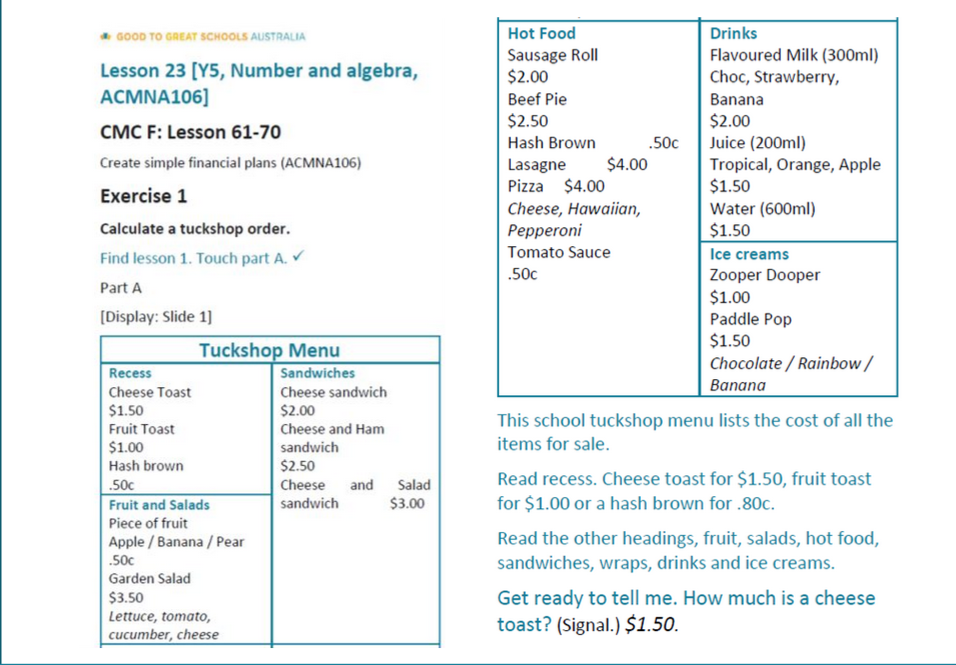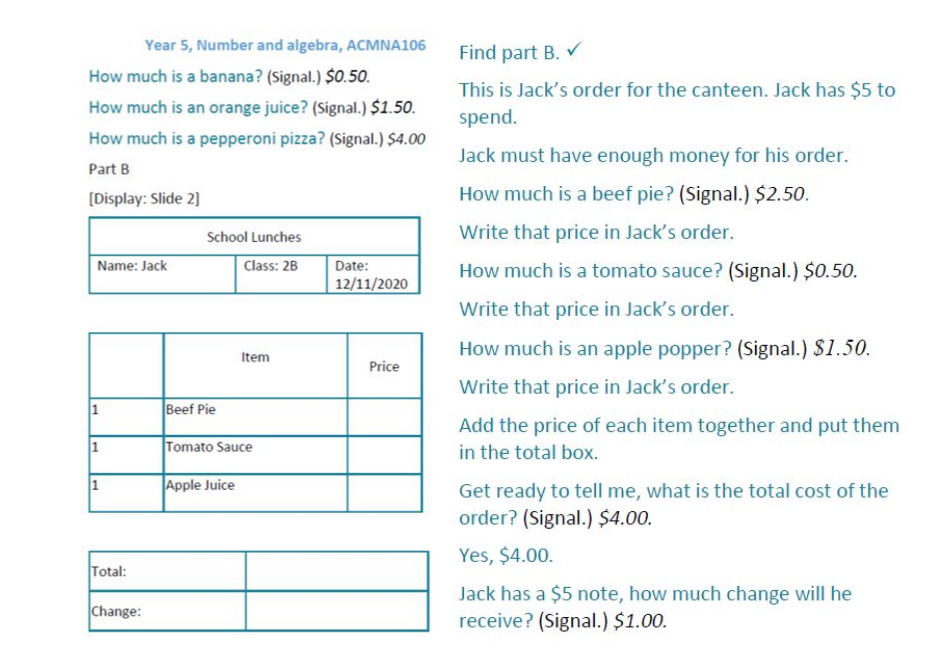Teach Connecting Math Concepts F (6)
-
Module introduction5 Topics
-
Overview21 Topics|1 Test
-
Cover
-
Lesson objective
-
Opening the lesson
-
Direct instruction overview
-
CMC overview
-
Teacher’s role in motivation
-
Affirmations
-
Materials
-
Time requirements
-
Placement testing
-
Grouping, seating, STAR, transitions
-
Teaching routines for effective transitions
-
Review
-
Script features
-
Script with brackets
-
Board work
-
Lined-paper icons
-
Maths learning behaviours
-
Check your understanding
-
Review
-
Lesson completed!
-
Cover
-
Connecting CMC to Oz-e-maths14 Topics|1 Test
-
Place value and rounding, fraction analysis tracks20 Topics|1 Test
-
Cover
-
Lesson objective
-
Opening the lesson
-
Point—touch signal
-
Point-touch signal
-
Auditory signal
-
Auditory signal
-
Place value and rounding track
-
Corrections spoken and written
-
Decimal values
-
Rounding
-
Corrections and repeat until firm
-
Rounding decimal values
-
Fraction analysis
-
Properties and relationships
-
Properties and relationships continued
-
Fraction comparison
-
Check your understanding
-
Review
-
Lesson completed!
-
Cover
-
Equivalence: fractions/decimals/per cents, inverse operations, ratio and proportion word problems tracks17 Topics|1 Test
-
Cover
-
Lesson objective
-
Opening the lesson
-
Fractions as mixed numbers
-
The tick
-
Mixed numbers/fractions as decimals
-
Per cent values and mixed numbers as fractions
-
Corrections
-
Error Correction Procedure
-
Corrections tips
-
Inverse operations
-
Ratio and proportion basic problems
-
Ratio and proportion classification problems
-
Script success
-
Check your understanding
-
Review
-
Lesson completed!
-
Cover
-
Word problems: basic operation track17 Topics|1 Test
-
Cover
-
Lesson objective
-
Opening the lesson
-
Whole-number word problems
-
Number families
-
Comparison word problems
-
Start-end problems
-
Observe students and give feedback
-
Expressions and unit conversion
-
Corrections spoken and written
-
Delivering lessons fluently and clearly includes correcting all errors
-
Unit conversion and division
-
Fraction word problems
-
Mixed-number word problems
-
Check your understanding
-
Review
-
Lesson completed!
-
Cover
-
Algebraic translation word problems and probability tracks17 Topics|1 Test
-
Cover
-
Lesson objective
-
Opening the lesson
-
Uniform strategies
-
Algebra foundations
-
Auditory signal
-
Algebra foundations continued
-
Number families, signal and wait time
-
Word problems: fractions of a group
-
Word problems: fractions of a group continued
-
Comparison problems
-
Corrections and repeat until firm
-
Probability fractions
-
Probability equations
-
Check your understanding
-
Review
-
Lesson completed!
-
Cover
-
Column multiplication, division, mental math and mixed-number operations tracks19 Topics|1 Test
-
Cover
-
Lesson objective
-
Opening the lesson
-
Point-touch signal
-
Point-touch signal
-
Column multiplication
-
Division, single-digit divisors
-
Single-digit divisors
-
Two-digit divisors
-
Corrections spoken and written
-
Mental math
-
Pacing of instruction
-
Pacing of instruction
-
Mental math continued
-
Corrections and repeat until firm
-
Mixed-numbers operations
-
Check your understanding
-
Review
-
Lesson completed!
-
Cover
-
Coordinate system, data analysis, and fraction operations tracks19 Topics|1 Test
-
Cover
-
Lesson objective
-
Opening the lesson
-
Coordinate system – point
-
Lines, ratio and proportion, related rules
-
Active monitoring
-
Active Monitoring
-
Data analysis – tables
-
Average, balance beams, number lines and line plots
-
Corrections
-
Fraction operations
-
Addition/subtraction/multiplications
-
Unlike denominators
-
Division and multiplication representation
-
Positive praise
-
Using specific positive praise
-
Check your understanding
-
Review
-
Lesson completed!
-
Cover
-
Decimal operations, exponents, simplification and geometry tracks17 Topics|1 Test
-
Cover
-
Lesson objective
-
Opening the lesson
-
Decimal operations: addition-subtraction
-
Decimal multiplication and division
-
Powers of 10 and representation
-
Corrections
-
Decimal multiplication and division
-
Simplification
-
Geometry: area and perimeter
-
Angles and volume
-
Angles and volume continued
-
Surface area and quadrilaterals
-
Script success
-
Check your understanding
-
Review
-
Lesson completed!
-
Cover
-
Motivating students and independent work21 Topics|1 Test
-
Cover
-
Lesson objective
-
Opening the lesson
-
Basis of student motivation
-
Teacher-student game
-
Teacher-student game points
-
Teacher-student game
-
Providing affirmations
-
Communicate in a positive manner
-
Specific positive feedback
-
Using specific positive praise
-
Independent work
-
Independent work expectations
-
Work checks
-
Work checks for independent work
-
Conducting work checks
-
Work-checks
-
Independent work input on student progress tool
-
Check your understanding
-
Review
-
Lesson completed!
-
Cover
-
Mastery tests21 Topics|1 Test
-
Cover
-
Lesson objective
-
Opening the lesson
-
Mastery tests
-
Conducting mastery tests
-
Using mastery test information
-
Mastery test criterion
-
Providing remedies
-
Remediation and retesting how it is done
-
Mastery tests on SPT
-
Inputting data on SPT
-
Cumulative tests
-
Flight path concept
-
Expected lesson pacing
-
Lesson progress on SPT
-
Pacing of instruction
-
Pacing of instruction
-
Effective transitions
-
Check your understanding
-
Review
-
Lesson completed!
-
Cover
-
Bringing it all together21 Topics
-
Cover
-
Lesson objective
-
Opening the lesson
-
Teaching a complete lesson
-
Corrections and repeat until firm
-
Correction tips
-
Lesson 39, exercise 1
-
Point—touch signal
-
Point-touch signal
-
Lesson 39, exercise 2
-
Observe students and give feedback
-
Lesson 39, exercise 3
-
Lesson 39, exercise 4
-
Lined-paper icons
-
Lesson 39, exercise 5
-
Corrections spoken and written
-
Lesson 39, exercise 6
-
Script success
-
Lesson practice
-
Review
-
Lesson completed!
-
Cover
-
Module evaluation survey1 Topic
Participants 534
Program components — teacher guides
ddewell@goodtogreatschools.org.au August 7, 2023

Program components — teacher guides
The lessons are condensed into three teacher guides at distinct learning stages:
• Foundation to Year 2 — lessons one to six
• Year 3 to Year 4 — lessons seven to nineteen
• Year 5 to Year 6 — lessons twenty to twenty-eight.


The program overview
A program overview in each teacher guide outlines the content descriptors covered in each lesson, instructions for lesson delivery and resources included in the program.
It also includes a table outlining where each lesson is to be taught following which DI programs, which ensures students have the prior knowledge and skills needed to engage successfully with the lesson content.
The teacher guide
Teacher guides include important scripts with instructions including techniques and timings such as signals, repeating until firm, choral and individual responses, and error correction.
The scripts have the images from the student workbook, including answer keys, embedded for teacher reference.

